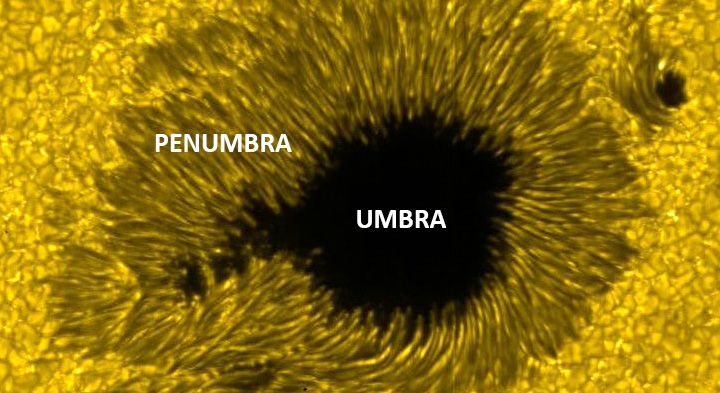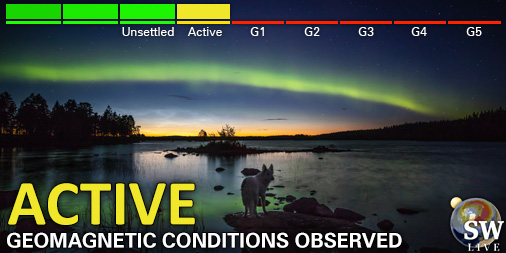Co to są plamy słoneczne?
Sunspots form on the surface of the Sun due to strong magnetic field lines coming up from within the Sun trough the solar surface and appear visibly as dark spots compared to their surroundings. These sunspots which can become many times bigger than the Earth are always dark because they are much cooler than the surrounding surface of the Sun itself. A big sunspot can have a temperature of 3700°C. This sounds like a lot but if we compare this with the temperature of the photosphere of the Sun which is about 5500°C, then you see that there is a considerable difference. As a matter of fact, if we could take a sunspot out of the Sun and place it into our night sky it would only be as bright as the full moon, a very big contrast with the bright Sun itself.
Sunspots are a common sight on our Sun during the years around solar maximum. Solar maximum or solar max is the period of greatest solar activity in the solar cycle of the Sun, where one solar cycle lasts about 11 years. Around solar minimum, only very few or even no sunspots can be found. Sunspots form where magnetic field lines come up from the Sun's interior trough the solar surface meaning that every sunspot has it's own polarity.
Plama słoneczna składa się z dwóch części:
- Ciemna część (umbra)
- Lighter part around the dark part (penumbra)

Regiony występowania plam słonecznych
The image below shows a large and complex group with numerous sunspots. This is called a sunspot group or an Active Region. Every day, all the sunspot regions on the Earth-facing solar disk are analysed for their eruptive threat and receive a number. This is done by the NOAA Space Weather Prediction Center. Sunspot regions, especially those with complex magnetic layouts, are know to cause a phenomenon called solar flares.

Rotacja Słońca
The Sun rotates around its axis just like Earth does. Solar features on the Sun like sunspot regions follow the rotation of the Sun. This means that a sunspot region travels across the solar disk from east to west as seen from Earth. This is important because sunspot regions need to be close to the central meridian (as seen from Earth) in order to be able to send coronal mass ejection towards Earth. It takes a sunspot region near the equator about 2 weeks to move from the east limb to west limb as seen from Earth. The further away a sunspot region is from the equator the longer it takes move across the face of the Sun. This is because the Sun rotates faster at its equator than at its poles. The rotational period is approximately 25.6 days at the equator and 33.5 days at the poles. Viewed from Earth as it orbits the Sun, the apparent rotational period of the Sun at its equator is about 28 days.

Animacja: Bardzo wielki region plam słoneczny 2192 obracający się na tarczę słoneczną skierowaną w stronę ziemi widziany przez Solar Dynamics Observatory.
Więcej o plamach słonecznych
Aktualne dane sugerują, że istnieje niewielkie prawdopodobieństwo pojawienia się zorzy polarnej w następujących regionach o wysokiej szerokości geograficznej w najbliższej przyszłości
Gillam, MB, Yellowknife, NTNajnowsze wiadomości
Najnowsze wiadomości z forum
Wesprzyj SpaceWeatherLive.com!
Wielu ludzi odwiedza SpaceWeatherLive aby śledzić aktywność słoneczną lub sprawdzić czy jest szansa na zaobserwowanie zorzy polarnej. Niestety, większy ruch na stronie oznacza większe koszty utrzymania serwera. Dlatego, jeśli jesteś zadowolony ze strony SpaceWeatherLive, zachęcamy do wspierania nas finansowo. Dzięki temu będziemy mogli utrzymać naszą stronę.

Alerty
04:15 UTC - Aktywność geomagnetyczna
Aktywne warunki geomagnetyczne (Kp4) Osiągnięty próg: 03:57 UTC
02:30 UTC - Indeks mocy półkuli
Model OVATION przewiduje, że index mocy półkuli osiągnie 50GW o 03:23 UTC
środa, 16 kwietnia 2025
21:45 UTC - Aktywność geomagnetyczna
Słaba burza geomagnetyczna G1 (Kp5) osiągnięty próg: 21:36 UTC
21:00 UTC - Aktywność geomagnetyczna
Bardzo silna burza geomagnetyczna G4 (Kp8) osiągnięty próg: 20:55 UTC
19:45 UTC - Aktywność geomagnetyczna
Silna burza geomagnetyczna G3 (Kp7) Osiągnięto próg: 19:25 UTC
Fakty na temat pogody kosmicznej
| Ostatnie rozbłyski klasy X | 2025/03/28 | X1.1 |
| Ostatnie rozbłyski klasy M | 2025/04/15 | M1.2 |
| Ostatnia burza geomagnetyczna | 2025/04/16 | Kp8- (G4) |
| Dni bez plam słonecznych | |
|---|---|
| Ostatni dzień bez skazy | 2022/06/08 |
| Średnia miesięczna liczba plam słonecznych | |
|---|---|
| marca 2025 | 134.2 -20.4 |
| kwietnia 2025 | 120.5 -13.7 |
| Ostatnie 30 dni | 118.3 -22.1 |






